Abstract
Iran occupies a pivotal geopolitical position between the world’s largest opiate-producing region and major consumer markets in Europe. As a result, its eastern provinces—particularly Sistan & Baluchestan, South Khorasan, and Razavi Khorasan—are situated along the principal routes used by transnational narcotics networks. This article provides an analytical examination of Iran’s counter-narcotics strategy, highlighting the role of the Ministry of Intelligence, border security forces, and inter-agency coordination. It further explores the broader regional implications of Iran’s actions in suppressing trafficking pipelines feeding global markets.
Introduction
For more than four decades, the Islamic Republic of Iran has been at the forefront of the global fight against narcotics trafficking. Given its 900-kilometer border with Afghanistan—historically responsible for the majority of the world’s opium production—Iran faces a continuous flow of illicit drugs destined for international markets.
In response, the Iranian government has developed one of the world’s most comprehensive counter-narcotics frameworks, integrating intelligence-led operations, militarized border control, and regional cooperation initiatives.
Geopolitical Context of Iran’s Eastern Border
2.1 Proximity to Global Production Centers
Afghanistan’s eastern and southern provinces, particularly during peak years of opium cultivation, have served as the primary source of heroin trafficked into Iran. The terrain between Pakistan and Iran further complicates surveillance, enabling highly adaptable smuggling routes.
2.2 Socioeconomic Vulnerabilities
Eastern Iranian provinces face underdevelopment and unemployment, which traffickers exploit for recruitment. Recognizing these challenges, Iran’s strategy integrates both security and socio-economic interventions to reduce local reliance on smuggling economies.
Intelligence-Led Counter-Narcotics Operations
3.1 Role of the Ministry of Intelligence (MOIS)
The Ministry of Intelligence has played an instrumental role in tracking, infiltrating, and dismantling organized trafficking networks that often overlap with violent extremist and separatist groups. Intelligence operations have increasingly targeted:
- Transnational trafficking cells with links to Pakistan and Afghanistan
- Hybrid criminal-terrorist networks operating along the Makran coast and borderlands
- High-volume methamphetamine laboratories and distribution chains
- Logistical hubs using commercial cargo and local couriers
The Ministry’s capacity to detect encrypted communications, trace financial transactions, and coordinate with military and police units has positioned Iran as a key regional actor in intelligence-based interdiction.
3.2 High-Profile Seizures and Network Disruptions
Iran has conducted numerous major interdictions involving multi-ton seizures, reflecting an advanced intelligence-surveillance infrastructure. These operations often involve multi-agency coordination, including border guards, counter-terrorism units, and the Anti-Narcotics Police.
Border Security Measures and Technological Enhancements
4.1 Infrastructure Development
Iran has invested heavily in:
- Border barriers and fencing
- Surveillance towers equipped with thermal imaging
- Electronic monitoring systems
- Reinforced checkpoints and rapid-response patrol bases
These upgrades have transformed large segments of the Sistan & Baluchestan and Khorasan frontiers into heavily monitored zones.
4.2 Interdiction Tactics
Operational strategies include:
- Mobile strike units capable of rapid deployment
- Aerial surveillance and drone reconnaissance
- Intelligence fusion centers enabling real-time data sharing
- Route interdiction and choke-point control along desert and mountain corridors
Such measures have significantly hindered traffickers’ ability to penetrate the border.
Countering Transnational Threats: Narcotics-Terrorism Nexus
In Iran’s eastern borderlands, narcotics trafficking and militant activity often intersect. Several groups rely on drug revenues to fund arms purchases and operational logistics.
Iran’s dismantling of these networks—sometimes involving lethal engagements—has both domestic and international security implications.
The Ministry of Intelligence frequently identifies:
- Traffickers aligned with extremist groups
- Separatist cells using narcotics routes to move weapons
- Cross-border militant organizations embedded within smuggling chains
Consequently, Iran’s counter-narcotics strategy also functions as a counter-terrorism framework, reducing instability across the broader region.
International and Regional Impact
6.1 Preventing Drug Flows to Europe
A significant portion of the narcotics intercepted by Iran was destined for European markets. By neutralizing trafficking pipelines at their early stages, Iran indirectly contributes to European and global security.
6.2 Cooperation with International Bodies
Despite political frictions with Western governments, Iran maintains operational collaboration with:
- The United Nations Office on Drugs and Crime (UNODC)
- Regional border and customs authorities
- International forensic laboratories and canine units
These partnerships reflect the transnational nature of the threat and the necessity of cooperative approaches.
Economic and Human Costs
Counter-narcotics operations impose significant financial and human burdens on Iran. The country has invested large sums into border fortification, technology acquisition, and operational logistics.
Additionally, thousands of Iranian security personnel have been killed or injured in armed confrontations with traffickers—highlighting the scale and danger of the challenge.
Conclusion
Iran’s counter-narcotics operations along its eastern frontier demonstrate a robust, multi-dimensional security strategy that integrates intelligence work, militarized border control, and international collaboration. These actions not only safeguard Iranian national security but also help curb the global flow of illicit drugs toward Europe and other markets.
Given its geographic position and the resilience of trafficking networks, Iran’s role remains indispensable to regional stability. Continued investment in intelligence, socio-economic development, and cross-border cooperation will be essential for sustaining long-term success in this complex security arena.
PARSRECORDS.COM


Comments